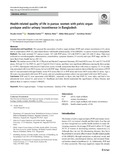Health-related quality of life in parous women with pelvic organ prolapse and/or urinary incontinence in Bangladesh
Citation
Imoto, A., Sarker, M., Akter, R., Matsuyama, A., & Honda, S. (2021). Health-related quality of life in parous women with pelvic organ prolapse and/or urinary incontinence in Bangladesh. International Urogynecology Journal, 32(4), 887-895. doi:10.1007/s00192-020-04410-5Abstract
Introduction and hypothesis We assessed the association of pelvic organ prolapse (POP) and urinary incontinence (UI), alone
and in combination (POP-UI), and related factors with health-related quality of life (HRQOL) in parous women in Bangladesh.
Methods The study included 357 parous women: 107 with POP alone, 124 with POP-UI, and 126 with UI alone. Data were
collected on sociodemographic characteristics, comorbidities, symptom duration, UI severity and type, POP stage, and the 12-
item Short-Form Health Survey (SF-12).
Results The median scores of the SF-12 Physical and Mental Component Summary (PCS and MCS) were 29.1 and 35.7 for POP
alone, 28.0 and 35.1 for POP-UI, and 33.9 and 42.0 for UI alone, and there were significant differences among the three groups
(p < 0.001). Participants with mixed UI had lower scores on both components than those with stress or urgency UI. UI severity
was associated with lower MCS scores, but not with POP stage. Multiple regression analysis showed that the coexistence of POP
and UI was associated with significantly worse PCS scores than UI or POP alone and worse MCS scores than UI alone. Age ≥
46 years was associated with lower PCS scores, and not completing primary school was associated with lower MCS scores.
Conclusion POP and UI were associated with HRQOL, especially in those who had POP-UI, were older, and had a low
educational level, mixed UI, and severe UI. Healthcare providers should understand the significance of these illnesses and
address them to improve women’s HRQOL.

